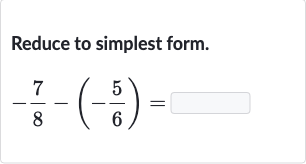AI tutor
Full solution
Q. Reduce to simplest form.
- Identify numbers and signs: Identify the numbers to be subtracted and their signs.We have two fractions, - and -. The second fraction has a double negative, which means it will become positive when simplified.
- Simplify double negative: Simplify the double negative in the second fraction.The expression - becomes because a negative times a negative is a positive.
- Find common denominator: Find a common denominator for the two fractions.The denominators are and . The least common multiple of and is , so we will use as the common denominator.
- Convert to common denominator: Convert each fraction to an equivalent fraction with the common denominator of .For -, we multiply the numerator and denominator by to get -.For , we multiply the numerator and denominator by to get .
- Subtract the fractions: Subtract the two fractions.Now we subtract - from to get .
- Perform the subtraction: Perform the subtraction. equals .
- Check for further simplification: Check if the result can be simplified further.The fraction is already in its simplest form because the numerator and denominator have no common factors other than .
More problems from Composition of linear functions: find an equation
QuestionGet tutor help

